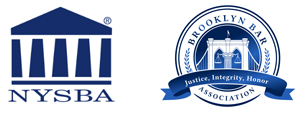In Alexim Holdings, LLC v McAuliffe, 2023 NY Slip Op 05581 [2d Dept Nov. 8, 2023], the court affirmed the dismissal of a client’s legal malpractice case, holding:
On a motion to dismiss a complaint pursuant to CPLR 3211(a)(7) for failure to state a cause of action, the court must accept the facts alleged in the pleading as true, accord the plaintiff the benefit of every favorable inference, and determine only whether the facts as alleged fit within any cognizable legal theory (see Leon v. Martinez, 84 N.Y.2d 83, 87–88, 614 N.Y.S.2d 972, 638 N.E.2d 511; Marinelli v. Sullivan Papain Block McGrath & Cannavo, P.C., 205 A.D.3d 714, 715, 169 N.Y.S.3d 90).
Here, the Supreme Court properly granted those branches of McAuliffe Law’s motion which were pursuant to CPLR 3211(a)(7) to dismiss the causes of action alleging legal malpractice, breach of contract, and breach of fiduciary duty insofar as asserted against it. The complaint failed to allege the existence of an attorney-client relationship, contractual relationship, or fiduciary relationship between the plaintiff and McAuliffe Law, which was not a party to the subject legal services agreement and did not even exist at the time of the misconduct alleged in the complaint. Thus, the complaint failed to state a cause of action sounding in, inter alia, legal malpractice or breach of fiduciary duty insofar as asserted against McAuliffe Law (see Keness v. Feldman, Kramer & Monaco, P.C., 105 A.D.3d 812, 813, 963 N.Y.S.2d 313).
The Supreme Court also properly granted those branches of the Tarbet defendants’ motion which were pursuant to CPLR 3211(a)(7) to dismiss the causes of action alleging legal malpractice, breach of fiduciary duty, and breach of contract insofar as asserted against them. “To state a cause of action to recover damages for legal malpractice, a plaintiff must allege: (1) that the attorney failed to exercise the ordinary reasonable skill and knowledge commonly possessed by a member of the legal profession; and (2) that the attorney’s breach of the duty proximately caused the plaintiff actual and ascertainable damages” (Dempster v. Liotti, 86 A.D.3d 169, 176, 924 N.Y.S.2d 484 [internal quotation marks omitted]; see Keness v. Feldman, Kramer & Monaco, P.C., 105 A.D.3d at 812, 963 N.Y.S.2d 313). “A claim for legal malpractice is viable, despite settlement of the underlying action, if it is alleged that settlement of the action was effectively compelled by the mistakes of counsel” (Katsoris v. Bodnar & Milone, LLP, 186 A.D.3d 1504, 1505, 131 N.Y.S.3d 89 [internal quotation marks omitted]). “The plaintiff is required to plead actual, ascertainable damages that resulted from the attorneys’ negligence” (Bua v. Purcell & Ingrao, P.C., 99 A.D.3d 843, 847, 952 N.Y.S.2d 592; see Marinelli v. Sullivan Papain Block McGrath & Cannavo, P.C., 205 A.D.3d at 716, 169 N.Y.S.3d 90; Katsoris v. Bodnar & Milone, LLP, 186 A.D.3d at 1506, 131 N.Y.S.3d 89). “Conclusory allegations of damages or injuries predicated on speculation cannot suffice for a malpractice action, and dismissal is warranted where the allegations in the complaint are merely conclusory and speculative” (Bua v. Purcell & Ingrao, P.C., 99 A.D.3d at 848, 952 N.Y.S.2d 592 [citations omitted]; see Marinelli v. Sullivan Papain Block McGrath & Cannavo, P.C., 205 A.D.3d at 716, 169 N.Y.S.3d 90).
Here, the complaint failed to adequately allege that the Tarbet defendants’ breach of their professional duty proximately caused the plaintiff to sustain actual and ascertainable damages (see Marinelli v. Sullivan Papain Block McGrath & Cannavo, P.C., 205 A.D.3d at 716, 169 N.Y.S.3d 90; Bua v. Purcell & Ingrao, P.C., 99 A.D.3d at 848, 952 N.Y.S.2d 592; Wald v. Berwitz, 62 A.D.3d 786, 787, 880 N.Y.S.2d 293). The plaintiff’s allegations that, but for the Tarbet defendants’ alleged negligence, the plaintiff would have received a more favorable settlement offer or outcome in the underlying action were conclusory and speculative (see Katsoris v. Bodnar & Milone, LLP, 186 A.D.3d at 1506, 131 N.Y.S.3d 89; Janker v. Silver, Forrester & Lesser, P.C., 135 A.D.3d 908, 910, 24 N.Y.S.3d 182). Accordingly, the complaint failed to state a cause of action to recover damages for legal malpractice insofar as asserted against the Tarbet defendants. Further, since the causes of action alleging breach of fiduciary duty and breach of contract insofar as asserted against the Tarbet defendants arose from the same operative facts as the legal malpractice cause of action and did not allege distinct damages, they were duplicative of the legal malpractice cause of action and thus, also subject to dismissal (see Cali v. Maio, 189 A.D.3d 1337, 1339, 134 N.Y.S.3d 806; Keness v. Feldman, Kramer & Monaco, P.C., 105 A.D.3d at 813, 963 N.Y.S.2d 313).
Richard A. Klass, Esq.
Your Court Street Lawyer
keywords:
#CourtStreetLawyer #legalmalpractice #CPLR 3211(a)(7)
Richard A. Klass, Esq., maintains a law firm engaged in civil litigation at 16 Court Street, 28th Floor, Brooklyn, New York. He may be reached at (718) COURT●ST or RichKlass@courtstreetlaw.com with any questions.
Prior results do not guarantee a similar outcome.
© 2023 Richard A. Klass






